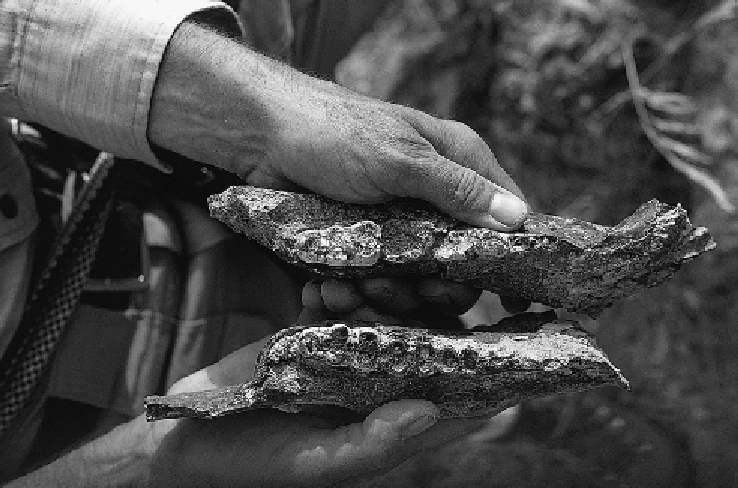Geoscience Reference
In-Depth Information
Figure 16.2. Pliocene pig mandible, Afar Desert, Ethiopia.
Once the vertebrate fossil has been identified, preferably to species level but if not at
least to genus level, the next step is to define the ecosystemwithin which such animals
occur (Jousse,
2004
). Usually a number of different animal genera are represented
within any given fossil assemblage, so it becomes possible to define the former
habitats more precisely. If the animal concerned has no living counterparts and is a
herbivore, it may be necessary to rely on tooth wear patterns and on the stable isotopic
composition of bones and teeth in order to reconstruct probable diet (van der Merwe,
1982
; Quade et al.,
1989
; Ayliffe and Chivas,
1990
; Cerling et al.,
1991
;Morgan
et al.,
1994
; WoldeGabriel et al.
1994
; WoldeGabriel et al.,
2001
; WoldeGabriel
et al.,
2009
; Cerling et al.,
2010
). Ideally, for such studies to be convincing, detailed
isotopic analysis of modern herbivore teeth are necessary, including close attention to
any seasonal changes in diet that may reflect responses of the plant cover to seasonal
changes in precipitation sources (Brookman and Ambrose,
2012
; Brookman and
Ambrose,
2013
). Such studies are still in their infancy.
P. deMenocal (
2004
) compared the African faunal record spanning the last 5 million
years with the marine evidence of Pliocene-Pleistocene wetter and drier phases linked
to orbital variations (see
Chapter 6
). He found evidence of step-like (
0.2 Ma)
changes in aridity and climatic variability at around 2.8, 1.7 and 1.0 Ma, all of which
coincidedwith the onset and intensification of high-latitude glacial cycles. The African
faunal evidence indicated more open habitats at 2.9-2.4Ma and after 1.8Ma, although
±

